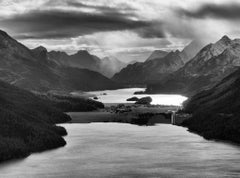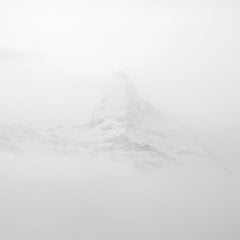Peter Mathis
Recent Sales
21st Century and Contemporary Contemporary Landscape Photography
Pigment
21st Century and Contemporary Contemporary Black and White Photography
Digital Pigment
2010s Black and White Photography
Pigment
2010s Photorealist Black and White Photography
Pigment
21st Century and Contemporary Photorealist Black and White Photography
Pigment
21st Century and Contemporary Contemporary Black and White Photography
Pigment
21st Century and Contemporary Landscape Photography
Archival Pigment
PETER MATHIS (AUSTRIA, B. 1961)
Peter Mathis was born in 1961 and lives in Hohenems in Austria. Since 1986, his professional work focused particularly on outdoor and sports photography. His international work took him to the most different places around the world. In 2007, he was awarded the title of Hasselblad Master and in 2008 the Master of European Photography from the Association of European Professional Photographers in Belgium. Since 2009, he has become more immersed in landscape photography and producing large-format works. Regardless of the type of picture, the authenticity of his work plays a prominent role for him. His essential design elements are light and structure. Light reflected by the object should be optimized so that it serves the overall structure and composition of the image. A picture, therefore, is not a simple reproduction of a predetermined motif but instead is developed with the camera while on site. He refuses any simulation of artificial light moods or movements on the computer that are not reproducible in a physical sense. He is only interested in “true” nature, that which we can experience, instead of computer-generated artifices. Many of his works aim to recognize and capture the fleeting nature of the moment, which requires enormous patience and experience. Quick and superficial effects are avoided at all costs. Good pictures are about the composition or the reproduction of motifs but about creating that freedom for interpretation, wherein the observer can see and experience the represented object in newer ways, time and again. By using the means available to him, the artist cannot only keep the interest alive but also to stimulate it anew.
Peter Mathis for sale on 1stDibs
Peter Mathis was born in 1961 and lives in Hohenems in Austria. Since 1986, his professional work focused particularly on outdoor and sports photography. His international work took him to the most different places around the world. In 2007, he was awarded the title of Hasselblad Master and in 2008 the Master of European Photography from the Association of European Professional Photographers in Belgium. Since 2009, he has become more immersed in landscape photography and producing large-format works. Regardless of the type of picture, the authenticity of his work plays a prominent role for him. His essential design elements are light and structure. Light reflected by the object should be optimized so that it serves the overall structure and composition of the image. A picture, therefore, is not a simple reproduction of a predetermined motif but instead is developed with the camera while on site. He refuses any simulation of artificial light moods or movements on the computer that are not reproducible in a physical sense. He is only interested in “true” nature, that which we can experience, instead of computer-generated artifices. Many of his works aim to recognize and capture the fleeting nature of the moment, which requires enormous patience and experience. Quick and superficial effects are avoided at all costs. Good pictures are about the composition or the reproduction of motifs but about creating that freedom for interpretation, wherein the observer can see and experience the represented object in newer ways, time and again. By using the means available to him, the artist cannot only keep the interest alive but also to stimulate it anew.
Finding the Right Black-white-photography for You
There’s a lot to love about black and white photography.
The unique and timeless quality of a black and white photograph accentuates any room. Some might argue that we’re naturally drawn to color photography because it’s the world we know best. This is a shared belief, particularly in the era of camera-phone photography, editing apps and the frenetic immediacy of sharing photos on social media. But when we look at black and white photography, we experience deep, rich shadows and tonal properties in a way that transfixes us. Composition and textures are crisp and engaging. We’re immediately drawn to the subjects of vintage street photography and continue to feel the emotional impact of decades-old photojournalism. The silhouettes of mountains in black and white landscape photography are particularly pronounced, while portrait photography and the skylines of urban cityscapes come to life in monochrome prints.
When decorating with fine photography, keep in mind that some color photographs may not be suitable for every space. However, you can be more daring with black and white photos. The gray tones are classic, sophisticated and generally introduce elegance to any corner of your home, which renders black and white prints amazingly versatile.
Black and white photography adapts to its surroundings like a chameleon might. A single large-scale black and white photograph above the sofa in your living room is going to work with any furniture style, and as some homeowners and designers today are working to introduce more muted tones and neutral palettes to dining rooms and bedrooms, the integration of black and white photography — a hallmark of minimalist decor — is a particularly natural choice for such a setting.
Another advantage to bringing black and white photography into your home is that you can style walls and add depth and character without worrying about disrupting an existing color scheme. Black and white photographs actually harmonize well with accent colors such as yellow, red and green. Your provocative Memphis Group lighting and bold Pierre Paulin seating will pair nicely with the black and white fine nude photography you’ve curated over the years.
Black and white photography also complements a variety of other art. Black and white photos pair well with drawings and etchings in monochromatic hues. They can also form part of specific color schemes. For example, you can place black and white prints in colored picture frames for a pop of color. And while there are no hard and fast rules, it’s best to keep black and white prints separate from color photographs. Color prints stand out in a room more than black and white prints do. Pairing them may detract attention from your black and white photography. Instead, dedicate separate walls or spaces to each.
Once you’ve selected the photography that best fits your space, you’ll need to decide how to hang the images. If you want to hang multiple photos, it’s essential to know how to arrange wall art. A proper arrangement can significantly enhance a living space.
On 1stDibs, explore a vast collection of compelling black and white photography by artists such as Mark Shaw, Jack Mitchell (a photographer you should know), Berenice Abbott and David Yarrow.

